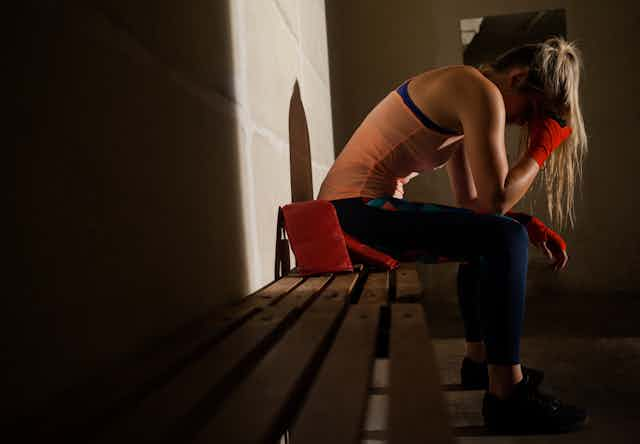The head coach of the Welsh men’s rugby squad, Warren Gatland, has built a reputation as one of the best coaches in the world. But his “intense training methods” have drawn comparisons to waterboarding, and his training programmes have included “psychological challenges” such as players being put in hoods and subjected to the sounds of crying babies. Gatland said that the training described “wasn’t brutal”, and that the feedback from players was positive.
In any other context, this behaviour from a boss might be (rightly) considered abuse. Professional rugby players, however, aren’t the first people who come to mind when people think of abuse victims.
Such treatment is described as necessary training to prepare for a big moment such as the World Cup. Some fans might consider these tactics justifiable if their team wins – as it happened, the Welsh squad lost the majority of their games last year.
From the amateur to the professional level, it’s clear that the definition of “good coaching” is the subject of constant debate. I have participated in sport throughout my life, competing internationally in American football and Aussie rules football. I have observed various coaching tactics and been fortunate to experience some of the better side of coaching. However, as a researcher, many of the practices I observed and experienced border on or constituted abuse.
Some athletes are forced to train while injured or concussed, and may be the target of emotional, sexual and physical abuse and varied forms of humiliation.
In my research on mixed martial arts (MMA), I found that many athletes (including myself) put up with the coaches’ worrying behaviour. This included coaches referring to athletes as “cunts”, “trannies” or “fags”. These words are small indicators into the pointed misogyny and homophobia of some sport environments – which can be toxic and dangerous environments for LGBTQ+ athletes and women.
“Coaching” also included comments about sexual “juice” on training shorts, and jokes about bulimia – particularly concerning given the high rate of eating disorders in sports. These “jokes” were not traded equally, but targeted and used in a disciplinary way, from the coach to the athletes, and never the other way around.
Justifying harm
If such behaviour were to be reported, these comments are likely to be legally be defined as sexual harassment or abuse.
But players and coaches alike justify it as either “tough love” or “transformative” coaching. According to my research participants in MMA, part of this justification was also that combat sports are meant to be “tough” and therefore “non-PC” (politically correct).
The unique role and environment of sport (and the coach-athlete relationship) can also enable this behaviour. Athletic environments are often physically isolated from other social spaces, and have different social expectations – you certainly can’t punch people for fun in an office.
In fact, many people go to sporting spaces precisely to get away from everyday life – to do things that aren’t normally allowed (or legal).
In these spaces, a club or coach can quickly become a new support system or family. To stay a part of this family, research shows that athletes may gloss over abusive behaviour in order to “strive for distinction” in their performance.
Conformity and self-sacrifice can also help athletes earn respect or a sense of belonging in a sporting space, while silencing their voices. Even recognising coaching tactics as abusive or harmful can be difficult, precisely because athletes are meant to trust their coaches.
Awareness of abuse
Another difficulty when discussing the distinction between coaching and abuse is that many people, including athletes, wrongly assume abuse is only a physical thing.
The UK National Report of Child Abuse in Sport revealed that 73% of respondents reported interpersonal violence as a child, with psychological forms of violence responsible for the highest number of incidents. These findings show that nonphysical abuse from coaches is prevalent, though many victims may not recognise it as abuse, or are reluctant to label it as such.

As I discuss in my research, I didn’t realise that my time in MMA gyms was somewhat traumatic until after I finished my research, precisely because nothing physical ever happened. However, I did always have a strange “feeling” when I was at the gym.
I wish I had been able to share these feelings with fellow athletes. I wish I felt brave enough to say “stop” (or to return a “fuck off!”). I wish I didn’t carry so much shame with me.
However, athletes may not be able to have these conversations if the perpetrator is someone in a welfare role (including the coaching staff and other team administrators and support staff). Reports of institutional sexism and misogyny in Welsh rugby and the Spanish football president Luis Rubiales’ nonconsensual kiss of a female player show that, often, the sport’s governing body is part of the problem. With such stories in the headlines, athletes have little hope that reporting an incident would even be dealt with.
Coaches passing a Disclosure and Barring Service (DBS) check, or an online module on sexual harassment is not enough to make changes to the blurred boundaries between “tough” coaching and harm which are deeply embedded in sporting culture.
More conversations are needed about the possibility of violence and abuse in coach-athlete relationships, and to support athletes to trust themselves if something feels wrong. There should also be clear protocols for reporting behaviour, regardless of the level and type of sport played.
“Blood, sweat and tears” is a well-known phrase when it comes to sporting glory, but it shouldn’t be an instruction manual.

